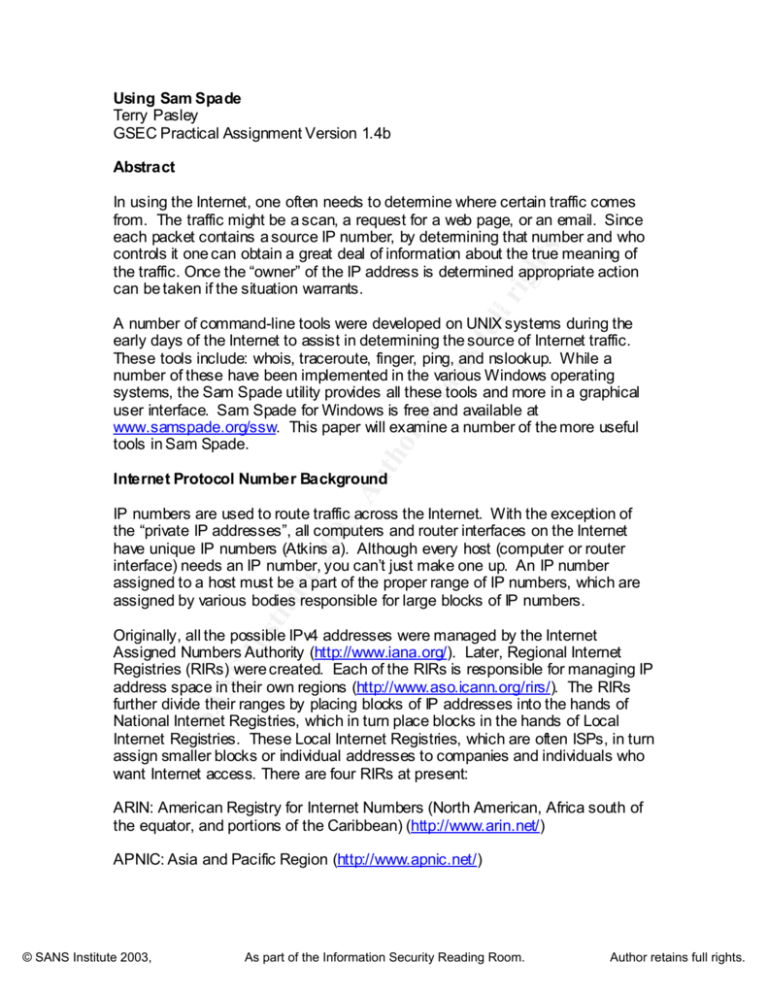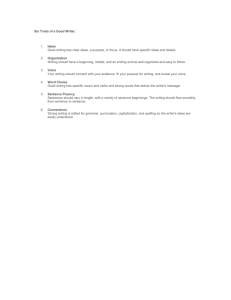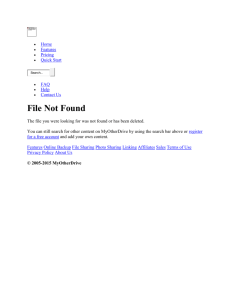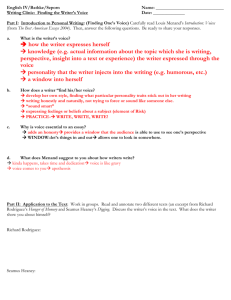SANS Institute 2003, Author retains full rights
advertisement

Using Sam Spade Terry Pasley GSEC Practical Assignment Version 1.4b Abstract ut ho rr eta ins fu ll r igh ts In using the Internet, one often needs to determine where certain traffic comes from. The traffic might be a scan, a request for a web page, or an email. Since each packet contains a source IP number, by determining that number and who controls it one can obtain a great deal of information about the true meaning of the traffic. Once the “owner” of the IP address is determined appropriate action can be taken if the situation warrants. Key fingerprint = AF19 FA27 2F94 998D FDB5 DE3D F8B5 06E4 A169 4E46 A number of command-line tools were developed on UNIX systems during the early days of the Internet to assist in determining the source of Internet traffic. These tools include: whois, traceroute, finger, ping, and nslookup. While a number of these have been implemented in the various Windows operating systems, the Sam Spade utility provides all these tools and more in a graphical user interface. Sam Spade for Windows is free and available at www.samspade.org/ssw. This paper will examine a number of the more useful tools in Sam Spade. ,A Internet Protocol Number Background sti tu te 20 03 IP numbers are used to route traffic across the Internet. With the exception of the “private IP addresses”, all computers and router interfaces on the Internet have unique IP numbers (Atkins a). Although every host (computer or router interface) needs an IP number, you can’t just make one up. An IP number assigned to a host must be a part of the proper range of IP numbers, which are assigned by various bodies responsible for large blocks of IP numbers. © SA NS In Originally, all the possible IPv4 addresses were managed by the Internet Assigned Numbers Authority (http://www.iana.org/). Later, Regional Internet Registries (RIRs) were created. Each of the RIRs is responsible for managing IP address space in their own regions (http://www.aso.icann.org/rirs/). The RIRs further divide their ranges by placing blocks of IP addresses into the hands of National Internet Registries, which in turn place blocks in the hands of Local Internet Registries. These Local Internet Registries, which are often ISPs, in turn assign smaller blocks or individual addresses to companies and individuals who want Internet access. There are four RIRs at present: ARIN: American Registry for Internet Numbers (North American, Africa south of Key the equator, fingerprintand = AF19 portions FA27of2F94 the Caribbean) 998D FDB5 (http://www.arin.net/) DE3D F8B5 06E4 A169 4E46 APNIC: Asia and Pacific Region (http://www.apnic.net/) © SANS Institute 2003, As part of the Information Security Reading Room. Author retains full rights. LACNIC: Latin America and portions of the Caribbean (http://www.lacnic.net/). RIPE: Europe, Parts of Asia, Africa north of the equator, and the Middle East (http://www.ripe.net/). fu ll r igh ts There are numerous National Internet Registries that can be accessed from the above web sites. In the process of determining the owner of an IP number it is necessary to search the IP registration databases maintained by each Registry. This is done using the “whois” utility, which is discussed later in this paper. It is also sometimes useful to look at the entire IPv4 address space assignments. This can be found at http://www.iana.org/assignments/ipv4-address-space. rr eta ins The fingerprint assigned =IPAF19 address used998D in each packet sent from a host Key FA27is2F94 FDB5 DE3D F8B5 06E4 A169machine 4E46 as the source address for the IP packet. This address is used to return response packets to a particular machine. Although there are ways to conceal the true source of a particular packet (using anonymous IP proxies), determining the person or entity controlling a particular address will often give you the true source of a packet, some idea of the intent of the packet, and someone to complain to if the intent of the packet is questionable. ut ho Sam Spade NS In sti tu te 20 03 ,A Sam Spade is a free utility containing tools to gather information on Internet hosts, analyze email headers, display web site code, and perform several other tasks. Sam Spade has been called the “Swiss Army Knife of network analysis” (Hiner). This paper will look at how to use some of these tools, such as Whois, Ping, IPBlock, Dig, Traceroute, Finger, Browse Web, and Parse email headers. Most of the functionality contained in Sam Spade is available in other utilities, usually command-line, but Sam Spade presents them all in a single graphical user interface that allows one to concentrate on the problem at hand and not worry so much about the different tools needed for the particular task one is working on. Sam Spade also has built-in logging capabilities that are very handy in chronicling an investigation. Sam Spade for Windows is free and available at http://www.samspade.org/ssw. SA Getting Started with Sam Spade © The Sam Spade interface is composed of a menu bar, an address bar, a tool bar along the left side of the screen, a large “current” window, and a bar across the bottom of the screen where previous windows are accessible by clicking on them. Key There fingerprint are four=boxes AF19 FA27 on a bar 2F94across 998D the FDB5 topDE3D of theF8B5 Sam06E4 Spade A169 window, 4E46 under the menu bar. The first box on the left is the Address bar. This is the address that Sam Spade will apply the selected tool to. The other three boxes are part of the Options bar. First is a spin box allowing you to select the number of packets © SANS Institute 2003, As part of the Information Security Reading Room. Author retains full rights. fu ll r igh ts in a ping. Ten packets is the default. The next box is the Whois server text box. Several servers are pre-configured and more can be added to the list by editing the registry (Atkins b). The “Magic” setting lets Sam Spade make its best guess about which Whois server would be most appropriate for the given address. You can also add Whois servers directly to the text box, but these are not persistent. The final box is the DNS server to direct queries to. A default DNS server is configured under Edit, Options, Basic on the menu bar. DNS servers can also be added to this box. eta ins The current window displays the results of executing a tool. Text displayed color coded and is either: Normal text, Comments, Warnings, Diagnostics, Hotlinks, Headings/Data, or Email Headers. By going to Edit on the menu bar, then Options, then clicking on the Colour you DE3D can customize the color of each. Key fingerprint = AF19 FA27 2F94 998Dtab FDB5 F8B5 06E4 A169 4E46 Right-clicking on a Hotlink will bring up a short menu based on what you could reasonably do with the type of Hotlink you clicked on. Left-clicking on a Hotlink will place it into the address box so you can continue applying tools to it. rr Configuration 03 ,A ut ho Most of the tools in Sam Spade will function correctly upon installation, but there are a few tools that require some configuration. The configuration dialog box is reached by clicking Edit on the menu bar, then Options. Some things you might want to configure are: a default name server, your email address, a web site (for dial-up connection keepalive, if needed), a network news server, a time server, and log file locations. te 20 The Toolbar In sti tu There are a number of buttons along the left side of the screen. These are used to execute a number of the tools included in Sam Spade. The tools for looking up information about a remote host or domain are located on the Toolbar. Starting at the top, the important tools are: © SA NS Two Log buttons: One logs and closes the current window (where the results of tool execution are displayed), the other simply logs without closing the current window. The window will then be available for future reference by clicking on buttons arranged in a bar under the current window. The logging function is particularly useful in organizing the results of an in-depth investigation. A Copy button and a Paste button. Key fingerprint A Ping =button: AF19 FA27 Sends 2F94 a series 998D FDB5 of packets DE3DtoF8B5 the host 06E4indicated A169 4E46 in the address box. The number of packets sent is configurable on the options bar. Used to verify basic network connectivity, but is not conclusive since a number of hosts are configured to not respond to ping requests. © SANS Institute 2003, As part of the Information Security Reading Room. Author retains full rights. A DNS button: Performs an nslookup on the host specified in the address bar. Used to resolve an IP number to a fully qualified domain name (FQDN) or to resolve an FQDN to an IP number. fu ll r igh ts A Whois button: Provides ownership and contact information for the host specified in the address bar. The whois request is run against the server specified in the Whois server box on the Options bar. Whois servers are maintained by the various Regional Internet Registries, National Internet Registries, etc. (Falk). Sam Spade offers a “Magic” option for the Whois server that will automatically refer the whois request to the most likely whois server. When investigating the ownership of an IP address it is sometimes necessary to add whois F8B5 server to the list4E46 on the Key fingerprint = AF19 FA27 2F94 998Danother FDB5 DE3D 06E4 A169 Options bar, based on the results of previous whois queries. ho rr eta ins An IPBlock button: A whois variation used to determine the ownership and contact information for a block of IP addresses. IPBlock is very useful when you can’t determine more specific information about a host. IPBlock is also useful in determining a host’s upstream Internet service provider (ISP). In the case of spam or illegal hacking the ISP can be contacted. te 20 03 ,A ut A DIG (Domain Internet Groper) button: DIG is an advanced Domain Name Service (DNS) tool that returns all of the available Resource Records for a given domain or host, including the start of authority (SOA) record, mail exchange (MX) records, and name server (NS) records. DIG can give you a starting point or can keep your investigation going in some situations. NS In sti tu A Trace button: Traceroute shows the route packets may take to the host specified in the Address bar (since the Internet is always in flux, actual packets might take a different route in some places). Good for determining the upstream providers of Internet service, and for identifying delays. SA A Finger button: Finger obtains host/user information from a host running the finger daemon. Finger is usually disabled these days. © Using Sam Spade to Investigate an “Incident” One day recently I had my laptop plugged into my work network. I received an alert from ZoneAlarm® that the laptop was being access on TCP Port 80, by a host at address 200.xxx.yyy.zzz. The laptop was not running WWW services, Key and fingerprint our DHCP=server AF19 FA27 issued 2F94 the998D laptop’s FDB5 IP DE3D number, F8B5 so 06E4 thereA169 was no 4E46 legitimate reason for someone to think there was a web server at that IP address. ZoneAlarm® suggested this might be part of a Port 80 scan, so I checked the logs of a couple of our web servers and found the following: © SANS Institute 2003, As part of the Information Security Reading Room. Author retains full rights. 200.xxx.yyy.zzz, -, 12/3/02, 11:18:38, W3SVC1, <mywebserver>, <mywebserver IP address>, 16, 153, 623, 404, 3, GET, scripts/..Á%8s../winnt/system32/cmd.exe, /c+copy+c:\winnt\system32\cmd.exe+c:\inetpub\scripts\script.exe, fu ll r igh ts This seems to be an attack designed to exploit IIS’s Unicode Directory Traversal vulnerability (Keane). The attack utilizes the fact that the default security permissions of the IIS scripts folder is Everyone can read, write, and execute files. The attack first attempts to create a copy of the Windows cmd.exe file in the c:\inetpub\scripts folder, and then to upload a file, such as netcat to the c:\inetpub\wwwroot folder. Netcat (Wysopal) would then provide a command prompt to anyone telnetting to Port 80,FDB5 without anyF8B5 disruption of the4E46 www service. Key fingerprint = AF19 FA27 2F94 998D DE3D 06E4 A169 rr eta ins Based on the above, I concluded that the web server’s on my LAN were under attack and that I needed to determine the source of the attack. To do this I used Sam Spade. I started by entering the IP number of the attacker into the address bar and then clicking on the “Whois” button, using the Magic setting to let Sam Spade select the particular whois server to contact. Below is the result: ut ho ---------- 03 ,A 12/11/02 11:03:46 IP block 200.xxx.yyy.zzz Trying 200.xxx.yyy.zzz at ARIN Trying 200.xxx.yyy at ARIN tu te 20 OrgName: Latin American and Caribbean IP address Regional Registry OrgID: LNIC © SA NS In sti NetRange: 200.0.0.0 - 200.255.255.255 CIDR: 200.0.0.0/8 NetName: LACNIC-200 NetHandle: NET-200-0-0-0-1 Parent: NetType: Allocated to LACNIC NameServer: ARROWROOT.ARIN.NET NameServer: BUCHU.ARIN.NET NameServer: CHIA.ARIN.NET NameServer: DILL.ARIN.NET NameServer: NS.LACNIC.ORG NameServer: NS.DNS.BR NameServer: NS2.DNS.BR Key fingerprint Comment: = AF19This FA27 IP 2F94 address 998Drange FDB5has DE3D been F8B5 delegated 06E4 A169 to LACNIC. 4E46 Please see http://www.lacnic.net/ for further details, or check the WHOIS server located at whois.lacnic.net RegDate: 2002-07-27 © SANS Institute 2003, As part of the Information Security Reading Room. Author retains full rights. Updated: 2002-11-18 TechHandle: LACNIC-ARIN TechName: Latin American and Caribbean IP address Regional R TechPhone: (+55) 11 5509-3525 TechEmail: hostmaster@lacnic.net fu ll r igh ts OrgTechHandle: LACNIC-ARIN OrgTechName: Latin American and Caribbean IP address Regional R OrgTechPhone: (+55) 11 5509-3525 OrgTechEmail: hostmaster@lacnic.net # ARIN=Whois database, 2002-12-10 20:00 Key fingerprint AF19 FA27 2F94 last 998Dupdated FDB5 DE3D F8B5 06E4 A169 4E46 # Enter ? for additional hints on searching ARIN's Whois database. eta ins ----------- 03 ,A ut ho rr Sam Spade went to ARIN with this initial whois request. From the results, we can see that the address in question is in the range delegated to the Latin American and Caribbean IP address Regional Registry (lacnic.net). Note that we are given name server information and technical contacts, but more importantly we are given the address of lacnic’s whois server: whois.lacnic.net. I entered this into the whois server box on Sam Spade’s Option bar (whois.lacnic.net was not one of the preconfigured whois servers available) and clicked the “Whois” button again: te 20 ---------- SA NS In Copyright LACNIC lacnic.net The data below is provided for information purposes and to assist persons in obtaining information about or related to AS and IP numbers registrations By submitting a whois query, you agree to use this data only for lawful purposes. 2002-12-11 14:20:05 (BRST -02:00) © % % % % % % % sti tu 12/11/02 11:20:11 whois 200.xxx.yyy.zzz@whois.lacnic.net whois -h whois.lacnic.net 200.xxx.yyy.zzz ... inetnum: 200.128/9 status: allocated owner: Comite Gestor da Internet no Brasil Key fingerprint ownerid: = AF19 BR-CGIN-LACNIC FA27 2F94 998D FDB5 DE3D F8B5 06E4 A169 4E46 responsible: <deleted by writer> address: <deleted by writer> address: <deleted by writer> © SANS Institute 2003, As part of the Information Security Reading Room. Author retains full rights. fu ll r igh ts country: BR phone: <deleted by writer> [] owner-c: CGB tech-c: CGB inetrev: 200.128/9 nserver: NS.DNS.BR nsstat: 20021209 AA nslastaa: 20021209 nserver: NS1.DNS.BR nsstat: 20021209 AA nslastaa: 20021209 nserver: NS2.DNS.BR nsstat: = AF19 20021209 AA 998D FDB5 DE3D F8B5 06E4 A169 4E46 Key fingerprint FA27 2F94 nslastaa: 20021209 eta ins These addresses have been further assigned to Brazilian rr Contact information can be found at the WHOIS server sti tu te 20 03 ,A ut ho at whois.registro.br and at http://whois.nic.br 19950104 20020902 CGB Comite Gestor da Internet no Brasil <deleted by writer> <deleted by writer> <deleted by writer> BR <deleted by writer> [] 20020902 20020902 In remarks: users. remarks: located remarks: created: changed: nic-hdl: person: e-mail: address: address: country: phone: created: changed: SA NS % whois.lacnic.net accepts only direct match queries. % Types of queries are: POCs, ownerid, CIDR blocks, IP % and AS numbers. © ---------- The whois server at lacnic reports the IP number in question has been further delegated to the country of Brazil. Note that I have deleted addresses and contact information from the output. Also note that from the line: Key fingerprint inetnum: = AF19 200.128/9 FA27 2F94 998D FDB5 DE3D F8B5 06E4 A169 4E46 we are not yet to the subnet of the attacking machine (since I am not showing you the whole attacking IP number, you will have to take my word for this). We © SANS Institute 2003, As part of the Information Security Reading Room. Author retains full rights. do have the Brazilian whois server, whois.registro.br, to consult. I entered this into Sam Spade’s whois server box and clicked the “Whois” button again: ---------12/11/02 11:40:09 whois 200.xxx.yyy.zzz@whois.registro.br whois -h whois.registro.br 200.xxx.yyy.zzz ... eta rr ho sti tu te 20 03 ,A ut inetnum: 200.xxx.yyy/21 aut-num: <deleted by writer> abuse-c: <deleted by writer> owner: <deleted by writer> ownerid: <deleted by writer> responsible: <deleted by writer> address: <deleted by writer> address: <deleted by writer> phone: <deleted by writer> [] owner-c: <deleted by writer> tech-c: <deleted by writer> created: 20021111 changed: 20021111 inetnum-up: 200.xxx.0/17 ins fu ll r igh ts % Copyright registro.br % The data below is provided for information purposes % and to assist persons in obtaining information about or % related to domain name and IP number registrations % By submitting a whois query,FDB5 you agree use06E4 this data Key fingerprint = AF19 FA27 2F94 998D DE3D to F8B5 A169 4E46 % only for lawful purposes. % 2002-12-11 14:40:04 (BRST -02:00) © SA NS In nic-hdl-br: <deleted by writer> person: <deleted by writer> e-mail: <deleted by writer> address: <deleted by writer> address: <deleted by writer> phone: (<deleted by writer> created: 19981005 changed: 20020214 nic-hdl-br: <deleted by writer> person: <deleted by writer> Key fingerprint e-mail: = AF19 <deleted FA27 by 2F94 writer> 998D FDB5 DE3D F8B5 06E4 A169 4E46 address: <deleted by writer> address: <deleted by writer> phone: <deleted by writer> © SANS Institute 2003, As part of the Information Security Reading Room. Author retains full rights. created: 20000502 changed: 20020401 remarks: remarks: remarks: remarks: Security issues should also be addressed to <deleted by writer>, http:// <deleted by writer> Mail abuse issues should also be addressed to mail-abuse@<deleted by writer> fu ll r igh ts % whois.registro.br accepts only direct match queries. % Types of queries are: domains (.BR), BR POCs, CIDR blocks, % IP and AS numbers. ----------= AF19 FA27 2F94 998D FDB5 DE3D F8B5 06E4 A169 4E46 Key fingerprint ho rr eta ins We now have what appears to be a “local” ISP. From the subnet mask of /21 we can determine that this ISP is responsible for 211 or about 2,000 IP numbers. We also have contact information, including email addresses. I emailed one of the technical contacts with the information I had collected about this incident, which is standard procedure in these cases. I received a reply that he would check into it. tu te 20 03 ,A ut In the process of using Sam Spade I have determined that an investigation doesn’t always play out exactly this way. Sometimes it only takes a couple of tool clicks to go as far as you can go. Sometimes it’s much more involved. For any particular investigation you have to read the results as you go and let the results determine where you go next. I have also tried to determine whether it is better to do a whois on the host IP address or to do an IPBlock (IPBlock is based on whois). I see no difference in the cases I have looked at so far. ---------- NS In sti I have also tried to determine whether any of the other tools, such as DIG or nslookup, would serve as a more appropriate route in the investigation. Here is the output for the same IP number using DIG: © SA 12/11/02 14:56:59 dig 200.xxx.yyy.zzz @ <my DNS server> Dig zzz.yyy.xxx.200.in-addr.arpa@<my DNS server> ... Non-authoritative answer Recursive queries supported by this server Query for zzz.yyy.xxx.200.in-addr.arpa type=255 class=1 xxx.200.in-addr.arpa SOA (Zone of Authority) Primary NS: <deleted by writer> Key fingerprint Responsible = AF19 FA27 person: 2F94 998D <deleted FDB5byDE3D writer> F8B5 06E4 A169 4E46 serial: <deleted by writer> refresh:7200s (2 hours) retry:3600s (60 minutes) © SANS Institute 2003, As part of the Information Security Reading Room. Author retains full rights. expire:604800s (7 days) minimum-ttl:86400s (24 hours) ---------This isn’t terribly helpful as a starting point. Nslookup is no better: fu ll r igh ts ---------12/11/02 15:07:09 dns 200.xxx.yyy.zzz nslookup 200.xxx.yyy.zzz No reverse DNS (WSANO_DATA) Key fingerprint = AF19 FA27 2F94 998D FDB5 DE3D F8B5 06E4 A169 4E46 ---------- ho rr eta ins This just tells us there is no reverse DNS record (IP to Hostname mapping) available for the IP number in question. This does lead one to believe the address was being used by a workstation, perhaps a dial-up, because servers usually have reverse DNS records (technically called pointer, or PTR records). Of course this is just supposition on my part. ,A ut Sam Spade and Email tu te 20 03 Sam Spade also has a number of tools to apply to email in general, and to spam in particular. Spam, or unwanted email sent to hundreds or thousands of recipients, takes up server space, eats up our bandwidth, annoys the users, and is a security issue when the emails contain attachments with viruses. The tools for dealing with spam are found under Basics and Tools on the menu bar and include (Kessler): In sti SMTP VRFY: Used to verify whether an email address is a true address or is being forwarded. SA NS SMTP Relay check: Used to determine if a particular mail server will relay mail (pass the mail on to another server). You can use this to verify that your mail server is properly set to not relay mail. © Blacklist lookups and Abuse.net query: Two related tools that allow you to check web sites that keep track of known spammers. E-mail header analysis: Used to analyze the headers of an email address to determine where it really came from. Breaks an email header Key fingerprint down and = AF19 allows FA27 the2F94 other998D investigative FDB5 DE3D tools F8B5 such 06E4 as whois A169 4E46 to be used on hosts and domains found in the email header. Email headers © SANS Institute 2003, As part of the Information Security Reading Room. Author retains full rights. fu ll r igh ts A number of computers handle every email you send, typically a minimum of four computers: your computer, your email server, the email server of the recipient, and the recipient’s computer. Various (legitimate) headers are put on by the first three machines, and forged and/or misleading headers can also be added (Lucke). While a complete discussion of email headers and the ways they can be manipulated is beyond the scope of this paper, there are some basic steps that happen. The first header is put on by the mail client on your machine, the second by your mail server, and a third by the mail server of the person you are mailing. It looks like this at your mail client: From header: Email message: xxxxxxxxxxxxxxxxxxxxxxxxx Key fingerprint = AF19 FA27 2F94 998D FDB5 DE3D F8B5 06E4 A169 4E46 xxxxxxxxxxxxxxxxxxxxxxxxxxxxxxxxxxxxxx eta ins At your mail server another header is added: ut ho rr From mail server (sender’s mail server) From header: Email message: xxxxxxxxxxxxxxxxxxxxxxxxx xxxxxxxxxxxxxxxxxxxxxxxxxxxxxxxxxxxxxx ,A After going through the destination mail server: tu te 20 03 From mail server (recipient’s mail server) From mail server (sender’s mail server) From header: Email message: xxxxxxxxxxxxxxxxxxxxxxxxx xxxxxxxxxxxxxxxxxxxxxxxxxxxxxxxxxxxxxx In sti Note that each successive header is added to the front of the message. SA NS It is possible to introduce bogus information at both the sender’s mail client and at the sender’s mail server (or servers). One way of introducing misleading information is by included text that looks like a header as part of the message: © From header: Text that looks like header, but is really part of the message. Rest of the email message: xxxxxxxxxxxxxxxxxxxxxxxxx xxxxxxxxxxxxxxxxxxxxxxxxxxxxxxxxxxxxxxxxxxxxxxx This bogus From header would then be displayed by the mail client. The Key sender’s fingerprint mail server = AF19could FA27 also 2F94add 998D erroneous FDB5 DE3D information F8B5 06E4 in the A169 From: 4E46header, pretending to be someone else for example. © SANS Institute 2003, As part of the Information Security Reading Room. Author retains full rights. Normally your mail client is rather unsophisticated in its interpretation of the headers on a received message. That’s why a message that appears to be from someone often turns out to be from someone else. Of course, this is the plan. The message is supposed to appear to be something you would want to read instead of just deleting. Since most mail clients have a mechanism for showing you the headers (Muth b) you can analyze the headers yourself, but Sam Spade’s tools make this much easier. Let’s start with a typical email header: ho rr eta ins fu ll r igh ts ---- Forwarded message ---> Received: from mx3.hotmail.com (80.xxx.yyy.zzz [80.xxx.yyy.zzz]) by <mymailserver> with SMTP (Microsoft Exchange Internet Mail Service Version 5.5.2656.59) > id YLRDD6XP; Sat,998D 7 Dec 2002 06:20:42 Key fingerprint = AF19 FA27 2F94 FDB5 DE3D F8B5-0500 06E4 A169 4E46 > From: Bruno <Bruno@hotmail.com> > To: <terry.pasley@mydomain.com> > Subject: i am getting new ones on monday > MIME-Version: 1.0 > Content-Type: text/html; charset="US-ASCII" > Content-transfer-encoding: 7bit sti tu te 20 03 ,A ut This header claims the message is from someone at hotmail.com. Note the claim the message was received from mx3.hotmail.com (80.xxx.yyy.zzz [80.xxx.yyy.zzz]). My mail server also noted the source IP number on the packets containing the message. Let’s use Sam Spade to see what’s really going on here. First, select and copy the header, then paste it into Sam Spade’s “Parse Email Headers” tool. After clicking parse, we get the following output (the original output is in color, and I have done some formatting to distinguish certain parts of the output so I don’t have to reproduce the colors, which could be a problem for some readers): In ---------- © SA NS 12/11/02 21:28:32 Input The Received: headers are the important ones to read My comments are just hints, and should be considered only an opinion. I may have guessed wrong, or things may have changed since I was written Received: from mx3.hotmail.com (80.xxx.yyy.zzz [80.xxx.yyy.zzz]) by <mymailserver> with SMTP Key fingerprint (Microsoft = AF19Exchange FA27 2F94Internet 998D FDB5 Mail Service DE3D F8B5 Version 06E4 A169 4E46 5.5.2656.59) id YLRDD6XP; Sat, 7 Dec 2002 06:20:42 -0500 This received header was added by your mailserver <mymailserver> received this from someone claiming © SANS Institute 2003, As part of the Information Security Reading Room. Author retains full rights. to be mx3.hotmail.com but really from 80.xxx.yyy.zzz(No rDNS) All headers below may be forged fu ll r igh ts From: Bruno <Bruno@hotmail.com> Many spams are forged to appear connected to hotmail.com. They probably aren't from there. If the spam is soliciting replies to a hotmail.com address tell abuse@hotmail.com and the mailbox will die. eta ins To: <terry.pasley@mydomain.com> Subject:= iAF19 am getting new998D ones FDB5 on monday Key fingerprint FA27 2F94 DE3D F8B5 06E4 A169 4E46 MIME-Version: 1.0 Content-Type: text/html; charset="US-ASCII" Content-transfer-encoding: 7bit rr ---------- 03 ,A ut ho Notice from the indented comments that the email purports to be from someone at hotmail.com, but Sam Spade checks the forwarding mail server name against the source IP number of the message (80.xxx.yyy.zzz ) and determines they don’t match. Next I click on 80.xxx.yyy.zzz, which places the address into the address bar. Now I can use the Sam Spade tools to determine who 80.xxx.yyy.zzz really belongs to. Using whois and the “Magic” setting: te 20 ---------- In sti tu 12/15/02 09:19:57 IP block 80.xxx.yyy.zzz Trying 80.xxx.yyy.zzz at ARIN Trying 80.48.123 at ARIN NS OrgName: RIPE Network Coordination Centre OrgID: RIPE © SA NetRange: 80.0.0.0 - 80.255.255.255 CIDR: 80.0.0.0/8 NetName: 80-RIPE NetHandle: NET-80-0-0-0-1 Parent: NetType: Allocated to RIPE NCC NameServer: NS.RIPE.NET Key fingerprint NameServer: = AF19AUTH62.NS.UU.NET FA27 2F94 998D FDB5 DE3D F8B5 06E4 A169 4E46 NameServer: NS3.NIC.FR NameServer: SUNIC.SUNET.SE NameServer: MUNNARI.OZ.AU © SANS Institute 2003, As part of the Information Security Reading Room. Author retains full rights. NameServer: NS.APNIC.NET NameServer: SVC00.APNIC.NET Comment: These addresses have been further assigned to users in the RIPE NCC region. Contact information can be found in the RIPE database at whois.ripe.net fu ll r igh ts RegDate: Updated: 2002-09-11 OrgTechHandle: RIPE-NCC-ARIN OrgTechName: RIPE NCC Hostmaster OrgTechPhone: +31 20 535 4444 OrgTechEmail: nicdb@ripe.net Key fingerprint = AF19 FA27 2F94 998D FDB5 DE3D F8B5 06E4 A169 4E46 eta ins # ARIN Whois database, last updated 2002-12-14 20:00 # Enter ? for additional hints on searching ARIN's Whois database. rr ---------- ut ho Again, we need to check a whois server closer to the machine in question, so I’ll use whois again, this time using the ripe.net whois server: ,A ---------- 03 12/15/02 09:32:29 whois 80.xxx.yyy.zzz@whois.ripe.net In sti tu te 20 whois -h whois.ripe.net 80.xxx.yyy.zzz ... % This is the RIPE Whois server. % The objects are in RPSL format. % % Rights restricted by copyright. % See http://www.ripe.net/ripencc/pub-services/db/copyright.html © SA NS inetnum: 80.xx.yyy.0 - 80.xx.yyy.255 netname: <deleted by writer> descr: <deleted by writer> descr: Lodz country: PL admin-c: <deleted by writer> tech-c: <deleted by writer> status: ASSIGNED PA mnt-by: <deleted by writer> Key fingerprint changed: = AF19<deleted FA27 2F94 by 998D writer>FDB5 DE3D F8B5 06E4 A169 4E46 source: RIPE route: © SANS Institute 2003, 80.xx.0.0/13 As part of the Information Security Reading Room. Author retains full rights. descr: descr: origin: notify: mnt-by: changed: source: <deleted by writer> Provider Local Registry <deleted by writer> <deleted by writer> <deleted by writer> <deleted by writer> RIPE SA --------- NS In sti tu te 20 03 ,A ut person: <deleted by writer> address: <deleted by writer> address: <deleted by writer> address: <deleted by writer> address: POLAND phone: <deleted by writer> fax-no: <deleted by writer> e-mail: <deleted by writer> nic-hdl: <deleted by writer> mnt-by: <deleted by writer> changed: <deleted by writer> source: RIPE ho rr eta ins fu ll r igh ts person: <deleted by writer> address: <deleted by writer> address: <deleted by writer> address: <deleted by writer> address: Poland Key fingerprint = AF19 FA27 2F94 998D FDB5 DE3D F8B5 06E4 A169 4E46 phone: <deleted by writer> fax-no: <deleted by writer> e-mail: <deleted by writer> nic-hdl: <deleted by writer> mnt-by: <deleted by writer> changed: <deleted by writer> source: RIPE © So the email message is not from someone at hotmail after all, but from a company in Poland. At this point you would use Sam Spade to check the source of the message to see if it’s listed in the MAPS (Mail Abuse Prevention System) mail abuse database (Muth a). For the email above, nothing was found. There is also an abuse email button in Sam Spade that will check whois.abuse.net for an Key email fingerprint address=toAF19 direct FA27 complaints 2F94 998D to: FDB5 DE3D F8B5 06E4 A169 4E46 ---------- © SANS Institute 2003, As part of the Information Security Reading Room. Author retains full rights. 12/15/02 09:59:21 Abuse address lookup for <deleted by writer> whois -h whois.abuse. <deleted by writer>... abuse@<deleted by writer> ---------- fu ll r igh ts You could also report unwanted or deceptive messages to the Federal Trade Commission, who maintains a database of such messages to pursue law enforcement actions against people who send deceptive email (http://www.ftc.gov/bcp/conline/pubs/online/inbox.htm). Key fingerprint = AF19 FA27 2F94 998D FDB5 DE3D F8B5 06E4 A169 4E46 Web Tools rr eta ins Sam Spade also contains a web crawler that will list all the linked pages in a web site, and a web browsing tools that will show you the html for a web page. These tools are very handy in investigating a web site that could have less than honorable intentions. ut ho Sam Spade Online Tools tu te 20 03 ,A There is also an online version of several of the tools available at http://www.samspade.org/t/. The online tools are handy in those cases you are working at a different computer from your usual workstation or if you are working behind a restrictive firewall. I noticed that several of the installed tools will not work if you are running ZoneAlarm®, for example. There are some issues with the online tools, however. When doing a whois using the “Magic” setting (explained later) I repeatedly received the following message: NS In sti SamSpade.org is being null-routed by ARIN due to high traffic. This service will not be available until that is resolved. Please do not contact ARIN about this. SA When I tried a whois to apnic.net I received the following message: © % [whois.apnic.net node-2] %ERROR:201: access denied% % Access from your host has been permanently denied due to % repeated excessive querying of the database. To reinstate % your host's access to the database please see: % http://www.apnic.net/db/dbcopyright.html Key fingerprint = AF19 FA27 2F94 998D FDB5 DE3D F8B5 06E4 A169 4E46 Apparently some of the whois servers are blocking/ignoring requests made through the Sam Spade online whois tool. There may be other such issues. © SANS Institute 2003, As part of the Information Security Reading Room. Author retains full rights. Conclusion fu ll r igh ts While there is nothing in Sam Spade that you can’t do other ways or from other sources, the combination of the tools, their ease of use and integration into a clean, functional GUI, running in the Windows environment, makes Sam Spade a very attractive package. Sam Spade can help you with several of your day-today tasks as a security professional, and the fact that it is free only makes it more attractive. References: Atkins, Steve a. “Internet Protocol Addressing.” http://www.samspade.org/d/ipdns.html. Key fingerprint = AF19 FA27 2F94 998D FDB5 DE3D F8B5 06E4 A169 4E46 eta ins Atkins, Steve b. “Things you should know.” http://www.samspade.org/ssw/tips.html. rr Falk, Ed. “Notes on whois.” http://www.rahul.net/falk/whois.html. ut ho Federal Trade Commission. “You’ve Got Spam: How to “Can” Unwanted Email.” April 2002. http://www.ftc.gov/bcp/conline/pubs/online/inbox.htm. 03 ,A Hiner, Jason. “Sam Spade: The Swiss Army Knife of network analysis.” 20 December 2000. http://libra.unitbv.ro/internet/tools/samspade.htm. te 20 Keane, Justin. “IIS Unicode Directory Traversal Exploit Explained.” 2002. http://www.madirish.net/tech.php?section+7&article=57. sti tu Kessler, Gary. “Sam Spade: A Multifunction Information Toolkit.” May 2001. http://www.garykessler.net/library/is_tools_sam_spade.html. NS In Lucke, Ken. “Reading Email Headers.” 1997. http://www.stopspam.org/email/headers/headers.html. SA Muth, Doug a. “Blocking Spam.” http://www.claws-and-paws.com/spam-l/blocking.html. © Muth, Doug b. “Tracking Spam.” http://www.claws-and-paws.com/spam-l/tracking.html. Wysopal, Chris. “Netcat 1.10 for NT - nc11nt.zip.” 2 February 1998. http://www.atstake.com/research/tools/nc11nt.txt. Key fingerprint = AF19 FA27 2F94 998D FDB5 DE3D F8B5 06E4 A169 4E46 © SANS Institute 2003, As part of the Information Security Reading Room. Author retains full rights.





